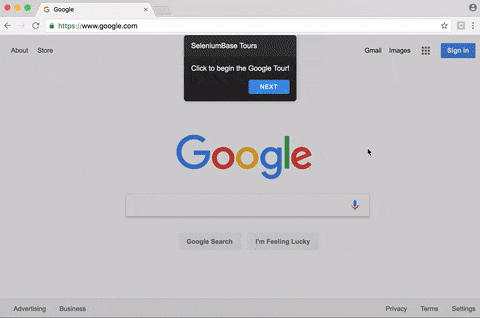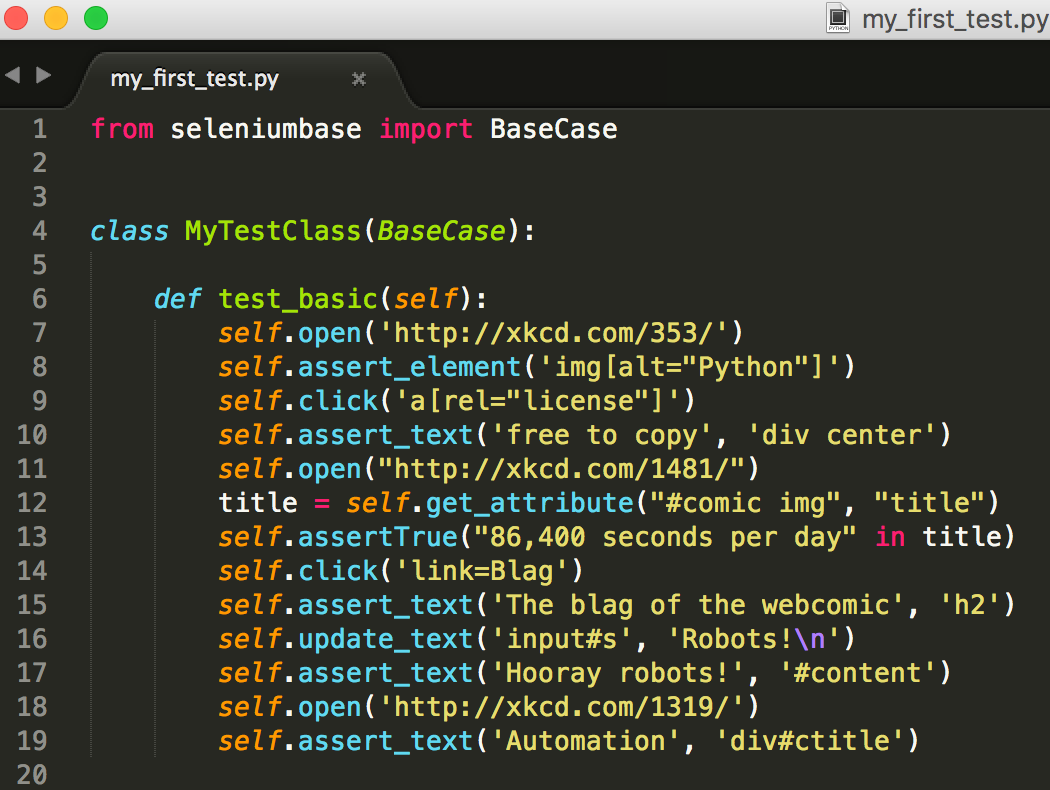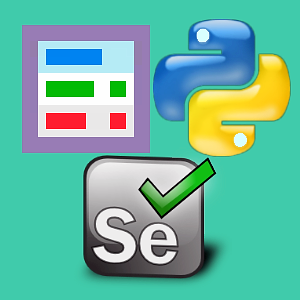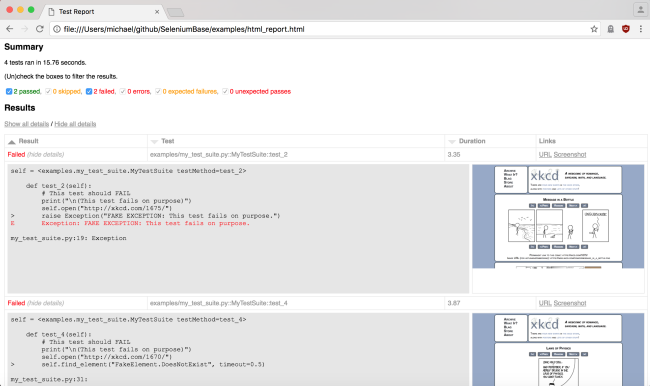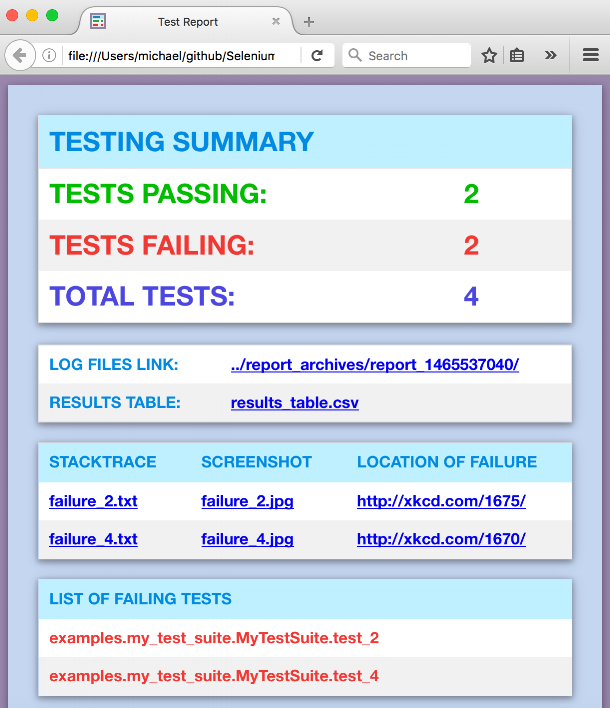Reliable Browser Automation & Testing with Selenium-WebDriver and Pytest.
(Above: my_first_test.py from examples/ running in demo mode, which adds JavaScript for highlighting page actions.)
pytest my_first_test.py --demo_mode
(Requires Git and Python 
git clone https://github.com/seleniumbase/SeleniumBase.git
Upgrade pip and setuptools to the latest versions:
python -m pip install -U pip setuptools
- (Depending on your user permissions, you may need to add
--userto the command if you're not inside a Python virtual environment, or use "sudo" on a UNIX-based OS if you're getting errors during installation.)
cd SeleniumBase
pip install -U -r requirements.txt
python setup.py install
- (Use
python setup.py developif configuring seleniumbase inside a virtual environment.) - (You can also get seleniumbase from the Python Package Index,
)
Install a web driver to the seleniumbase/drivers folder:
seleniumbase install chromedriver
- (You need a different web driver for each web browser you want to run automation on:
chromedriverfor Chrome,edgedriverfor Edge,geckodriverfor Firefox,operadriverfor Opera, andiedriverfor Internet Explorer.)
cd examples
pytest my_first_test.py --browser=chrome
- (Chrome is the default browser if not specified with
--browser)
Check out SeleniumBase Website Tours (in the examples/tour_examples folder). It's great for prototyping a website onboarding experience. See the Tours ReadMe for more details.
cd tour_examples
pytest google_tour.py
(Above: Actual demo of google_tour.py running on google.com)
For more detailed steps on getting started, see the Detailed Instructions section.
SeleniumBase automatically handles common WebDriver actions such as spinning up web browsers, waiting for page objects to load, saving screenshots during test failures, using a proxy server, and more. (Read about customizing test runs.)
(By default, CSS Selectors are used for finding page elements.)
(Using Pytest is strongly recommended)
pytest my_first_test.py --browser=chrome
nosetests test_suite.py --browser=firefox
Python methods that start with test_ will automatically be run when using pytest or nosetests on a Python file, (or on folders containing Python files).
This long line of standard WebDriver code,
self.driver.find_element_by_css_selector("textarea").send_keys("text")...becomes the following in SeleniumBase:
self.update_text("textarea", "text")(You can still use self.driver in your code.)
SeleniumBase methods automatically wait for page elements to finish loading before interacting with them (up to a timeout limit). This means you no longer need random time.sleep() statements in your code.
SeleniumBase includes an automated/manual hybrid solution called MasterQA, which speeds up manual testing by having automation perform all the web browser actions while the manual tester only validates what is seen.
SeleniumBase is compatible with Selenium Grid, MySQL, Docker, NodeJS, Google Cloud, and AWS.
Beyond test automation, SeleniumBase is perfect for automating tedious business tasks that you would perform in a web browser.
To learn about businesses using SeleniumBase, Click Here.
To see a full list of SeleniumBase features, Click Here.
Before installation, install Python and Git.
git clone https://github.com/seleniumbase/SeleniumBase.git
(A Git GUI tool like SourceTree may help.)
(OPTIONAL) To learn how to create a Python virtual environment, see this ReadMe.
If you're installing SeleniumBase from a cloned copy on your machine, use:
cd SeleniumBase
pip install -r requirements.txt --upgrade
python setup.py install
If you're installing SeleniumBase from the Python Package Index 
pip install -U seleniumbase --no-cache-dir
If you're installing SeleniumBase directly from GitHub, use:
pip install -e git+https://github.com/seleniumbase/SeleniumBase.git@master#egg=seleniumbase
(If you encounter permission errors during installation while not using a virtual environment, you may need to add --user to your pip command. If you already have an older version of SeleniumBase installed, you may want to add --upgrade or -U to your pip command.)
SeleniumBase requires a web driver to run automation on web browers. For that, you'll need to either download a web driver to your path, or install a web driver with the SeleniumBase install command.
seleniumbase install chromedriver
seleniumbase install geckodriver
seleniumbase install edgedriver
(geckodriver is the offical name of the Firefox driver)
Here's what the example script, my_first_test.py, looks like:
from seleniumbase import BaseCase
class MyTestClass(BaseCase):
def test_basic(self):
self.open("https://xkcd.com/353/")
self.assert_element('img[alt="Python"]')
self.click('a[rel="license"]')
self.assert_text("free to copy", "div center")
self.open("https://xkcd.com/1481/")
title = self.get_attribute("#comic img", "title")
self.assert_true("86,400 seconds per day" in title)
self.click("link=Blag")
self.assert_text("The blag of the webcomic", "h2")
self.update_text("input#s", "Robots!\n")
self.assert_text("Hooray robots!", "#content")
self.open("https://xkcd.com/1319/")
self.assert_exact_text("Automation", "#ctitle")(By default, CSS Selectors are used for finding page elements.)
Here's how to run the example script on various web browsers:
(NOTE: You can interchange pytest with nosetests at anytime.)
cd examples/
pytest my_first_test.py --browser=chrome
nosetests my_first_test.py --browser=firefox
(If no browser is specified, Chrome is used by default.)
If the example test is moving too fast for your eyes to see what's going on, you can run it in Demo Mode by adding --demo_mode on the command line, which pauses the browser briefly between actions, highlights page elements being acted on, and lets you know what test assertions are happening in real time:
pytest my_first_test.py --demo_mode
You can use the following in your scripts to help you debug issues:
import time; time.sleep(5) # sleep for 5 seconds (add this after the line you want to pause on)
import ipdb; ipdb.set_trace() # waits for your command. n = next line of current method, c = continue, s = step / next executed line (will jump)
import pytest; pytest.set_trace() # similar to ipdb, but specific to pytestTo pause an active test that throws an exception or error, add --pdb -s:
pytest my_first_test.py --browser=chrome --pdb -s
The code above will leave your browser window open in case there's a failure. (ipdb commands: 'c', 's', 'n' => continue, step, next).
Here are some other useful nosetest-specific arguments:
--logging-level=INFO # Hide DEBUG messages, which can be overwhelming.
-x # Stop running the tests after the first failure is reached.
-v # Prints the full test name rather than a dot for each test.
--with-id # If -v is also used, will number the tests for easy counting.
During test failures, logs and screenshots from the most recent test run will get saved to the latest_logs/ folder. Those logs will get moved to archived_logs/ if you have ARCHIVE_EXISTING_LOGS set to True in settings.py, otherwise log files with be cleaned up at the start of the next test run. The test_suite.py collection contains tests that fail on purpose so that you can see how logging works.
cd examples/
pytest test_suite.py --browser=chrome
pytest test_suite.py --browser=firefox
If you want to run tests headlessly, use --headless, which you'll need to do if your system lacks a GUI interface. Even if your system does have a GUI interface, it may still support headless browser automation.
To run Pytest multithreaded on multiple CPUs at the same time, add -n=NUM or -n NUM on the command line, where NUM is the number of CPUs you want to use.
If you want to pass additional data from the command line to your tests, you can use --data=STRING. Now inside your tests, you can use self.data to access that.
 Using SeleniumBase from a PyPI installation:
Using SeleniumBase from a PyPI installation:
You can install SeleniumBase without cloning the repo by doing this:
python -m pip install -U pip
pip install -U seleniumbase --no-cache-dir
You can then install webdrivers by doing this:
seleniumbase install chromedriver
seleniumbase install geckodriver
seleniumbase install edgedriver
seleniumbase install iedriver
seleniumbase install operadriver
(You'll need chromedriver if you want to run automation on Chrome, geckodriver if you want to run automation on Firefox, edgedriver for Microsoft Edge, etc.)
When creating your own test directories, keep these two things in mind:
For running tests outside of the SeleniumBase repo with Pytest, you'll want a copy of pytest.ini on the root folder. For running tests outside of the SeleniumBase repo with Nosetests, you'll want a copy of setup.cfg on the root folder. (Subfolders should include a blank __init__.py file.)
As a shortcut, you'll be able to run seleniumbase mkdir [DIRECTORY_NAME] to create a new folder that already contains necessary files and some example tests that you can run. Example:
seleniumbase mkdir browser_tests
cd browser_tests
pytest my_first_test.py --browser=chrome
(NOTE: Several command line args are different for Pytest vs Nosetests)
Using --html=report.html gives you a fancy report of the name specified after your test suite completes.
pytest test_suite.py --html=report.html
You can also use --junitxml=report.xml to get an xml report instead. Jenkins can use this file to display better reporting for your tests.
pytest test_suite.py --junitxml=report.xml
The --report option gives you a fancy report after your test suite completes.
nosetests test_suite.py --report
(NOTE: You can add --show_report to immediately display Nosetest reports after the test suite completes. Only use --show_report when running tests locally because it pauses the test run.)
If you wish to use a proxy server for your browser tests (Chrome and Firefox only), you can add --proxy=IP_ADDRESS:PORT as an argument on the command line.
pytest proxy_test.py --proxy=IP_ADDRESS:PORT
If the proxy server that you wish to use requires authentication, you can do the following (Chrome only):
pytest proxy_test.py --proxy=USERNAME:PASSWORD@IP_ADDRESS:PORT
To make things easier, you can add your frequently-used proxies to PROXY_LIST in proxy_list.py, and then use --proxy=KEY_FROM_PROXY_LIST to use the IP_ADDRESS:PORT of that key.
pytest proxy_test.py --proxy=proxy1
If you wish to change the User-Agent for your browser tests (Chrome and Firefox only), you can add --agent="USER AGENT STRING" as an argument on the command line.
pytest user_agent_test.py --agent="Mozilla/5.0 (Nintendo 3DS; U; ; en) Version/1.7412.EU"Here are some things you can do to setup a production environment for your testing:
-
You can setup a Jenkins build server for running tests at regular intervals. Jenkins has many plugins available, such as the Xvfb headless browser plugin for running tests on a machine with no GUI. If you have Xvfb running in the background, you can add
--headlessto your run command in order to utilize it. For more info about the Xvfb plugin, read this. For a real-world Jenkins example of headless browser automation in action, check out the SeleniumBase Google Cloud ReadMe. -
You can use the Selenium Grid to scale your testing by distributing tests on several machines with parallel execution. To do this, check out the SeleniumBase selenium_grid folder, which should have everything you need. The Selenium Grid ReadMe will help you get started.
-
If you're using the SeleniumBase MySQL feature to save results from tests running on a server machine, you can install MySQL Workbench to help you read & write from your DB more easily. You'll also need to install the MySQL Python client. Depending on your system, you may need to install additional requirements for this (such as on Windows). See Stackoverflow for more info.
pip install mysqlclient==1.3.14
- If you use Slack, you can easily have your Jenkins jobs display results there by using the Jenkins Slack Plugin. Another way to send messages from your tests to Slack is by using Slack's Incoming Webhooks API.
- If you're using AWS, you can setup an Amazon S3 account for saving your log files and screenshots for future viewing. SeleniumBase already has all the code you need to connect to S3. You'll need to modify settings.py with connection details to your instance and the location in S3 where you want log files to be saved. You'll also need to add "
--with-s3_logging" on the command line when you run your tests.
Here's an example of running tests with additional features enabled:
pytest [YOUR_TEST_FILE].py --browser=chrome --with-db_reporting --with-s3_logging -s
(NOTE: If you haven't configured your MySQL or S3 connections in settings.py, don't use --with-db_reporting or --with-s3_logging.)
When the testing_base plugin is used, if there's a test failure, the basic_test_info plugin records test logs, the page_source plugin records the page source of the last web page seen by the test, and the screen_shots plugin records the image of the last page seen by the test where the failure occurred. Make sure you always include testing_base whenever you include a plugin that logs test data. The db_reporting plugin records the status of all tests run into your MySQL DB. The s3_logging plugin uploads basic test info, screenshots, and page source into your S3 storage folder.
To simplify that long run command, you can create a *.cfg file, such as the one provided in the example, and enter your plugins there so that you can run everything by typing:
nosetests [YOUR_TEST_FILE].py --config=[MY_CONFIG_FILE].cfg
You can simplify that even more by using a setup.cfg file, such as the one provided for you in the examples folder. If you kick off a test run from within the folder that setup.cfg is location in, that file will automatically be used as your configuration, meaning that you wouldn't have to type out all the plugins that you want to use (or include a config file) everytime you run tests.
If you tell pytest/nosetests to run an entire file, it will run every method in that python file that starts with "test". You can be more specific on what to run by doing something like the following: (Note that the syntax is different for pytest vs nosetests.)
pytest [YOUR_TEST_FILE].py::[SOME_CLASS_NAME]::test_[SOME_TEST_NAME]
nosetests [YOUR_TEST_FILE].py:[SOME_CLASS_NAME].test_[SOME_TEST_NAME]
Let's try an example of a test that fails:
""" test_fail.py """
from seleniumbase import BaseCase
class MyTestClass(BaseCase):
def test_find_army_of_robots_on_xkcd_desert_island(self):
self.open("https://xkcd.com/731/")
self.assert_element("div#ARMY_OF_ROBOTS", timeout=1) # This should failYou can run it from the examples folder like this:
pytest test_fail.py
You'll notice that a logs folder, "latest_logs", was created to hold information about the failing test, and screenshots. Take a look at what you get. Remember, this data can be saved in your MySQL DB and in S3 if you include the necessary plugins in your run command (and if you set up the neccessary connections properly). For future test runs, past test results will get stored in the archived_logs folder if you have ARCHIVE_EXISTING_LOGS set to True in settings.py.
self.open("https://xkcd.com/378/") # This method opens the specified page.
self.go_back() # This method navigates the browser to the previous page.
self.go_forward() # This method navigates the browser forward in history.
self.refresh_page() # This method reloads the current page.
self.get_current_url() # This method returns the current page URL.
self.get_page_source() # This method returns the current page source.ProTip™: You may need to use the get_page_source() method along with Python's find() command to parse through the source to find something that Selenium wouldn't be able to. (You may want to brush up on your Python programming skills for that.) Ex:
source = self.get_page_source()
head_open_tag = source.find('<head>')
head_close_tag = source.find('</head>', head_open_tag)
everything_inside_head = source[head_open_tag+len('<head>'):head_close_tag]To click an element on the page:
self.click("div#my_id")ProTip™: In most web browsers, you can right-click on a page and select Inspect Element to see the CSS selector details that you'll need to create your own scripts.
self.update_text(selector, text) # updates the text from the specified element with the specified value. An exception is raised if the element is missing or if the text field is not editable. Example:
self.update_text("input#id_value", "2012")You can also use self.add_text() or the WebDriver .send_keys() command, but those won't clear the text box first if there's already text inside. If you want to type in special keys, that's easy too. Here's an example:
from selenium.webdriver.common.keys import Keys
self.find_element("textarea").send_keys(Keys.SPACE + Keys.BACK_SPACE + '\n') # the backspace should cancel out the space, leaving you with the newlinetext = self.get_text("header h2")attribute = self.get_attribute("#comic img", "title")self.wait_for_element_present("div.my_class", timeout=10)(NOTE: You can also use: self.assert_element_present(ELEMENT))
self.wait_for_element_visible("a.my_class", timeout=5)(NOTE: The short versions of this are self.find_element(ELEMENT) and self.assert_element(ELEMENT). The find_element() version returns the element)
Since the line above returns the element, you can combine that with .click() as shown below:
self.find_element("a.my_class", timeout=5).click()
# But you're better off using the following statement, which does the same thing:
self.click("a.my_class") # DO IT THIS WAY!ProTip™: You can use dots to signify class names (Ex: div.class_name) as a simplified version of div[class="class_name"] within a CSS selector.
You can also use *= to search for any partial value in a CSS selector as shown below:
self.click('a[name*="partial_name"]')self.assert_text("Make it so!", "div#trek div.picard div.quotes")
self.assert_text("Tea. Earl Grey. Hot.", "div#trek div.picard div.quotes", timeout=3)(NOTE: self.find_text(TEXT, ELEMENT) and self.wait_for_text(TEXT, ELEMENT) also do this. For backwords compatibility, older method names were kept, but the default timeout may be different.)
self.assert_true(myvar1 == something)
self.assert_equal(var1, var2)is_element_visible(selector) # is an element visible on a page
import logging
if self.is_element_visible('div#warning'):
logging.debug("Red Alert: Something bad might be happening!")is_element_present(selector) # is an element present on a page
if self.is_element_present('div#top_secret img.tracking_cookie'):
self.contact_cookie_monster() # Not a real method unless you define it somewhere
else:
current_url = self.get_current_url()
self.contact_the_nsa(url=current_url, message="Dark Zone Found") # Not a real method unless you define it somewhereAnother example:
def is_there_a_cloaked_klingon_ship_on_this_page():
if self.is_element_present("div.ships div.klingon"):
return not self.is_element_visible("div.ships div.klingon")
return Falseis_text_visible(text, selector) # is text visible on a page
def get_mirror_universe_captain_picard_superbowl_ad(superbowl_year):
selector = "div.superbowl_%s div.commercials div.transcript div.picard" % superbowl_year
if self.is_text_visible("For the Love of Marketing and Earl Grey Tea!", selector):
return "Picard HubSpot Superbowl Ad 2015"
elif self.is_text_visible("Delivery Drones... Engage", selector):
return "Picard Amazon Superbowl Ad 2015"
elif self.is_text_visible("Bing it on Screen!", selector):
return "Picard Microsoft Superbowl Ad 2015"
elif self.is_text_visible("OK Glass, Make it So!", selector):
return "Picard Google Superbowl Ad 2015"
elif self.is_text_visible("Number One, I've Never Seen Anything Like It.", selector):
return "Picard Tesla Superbowl Ad 2015"
elif self.is_text_visible("""With the first link, the chain is forged.
The first speech censored, the first thought forbidden,
the first freedom denied, chains us all irrevocably.""", selector):
return "Picard Wikimedia Superbowl Ad 2015"
elif self.is_text_visible("Let us make sure history never forgets the name ... Facebook", selector):
return "Picard Facebook Superbowl Ad 2015"
else:
raise Exception("Reports of my assimilation are greatly exaggerated.")What if your test opens up a new tab/window and now you have more than one page? No problem. You need to specify which one you currently want Selenium to use. Switching between tabs/windows is easy: Ex:
self.switch_to_window(1) # this switches to the new tab (0 is the first one)ProTip™: iFrames follow the same principle as new windows - you need to specify the iFrame if you want to take action on something in there Ex:
self.switch_to_frame('ContentManagerTextBody_ifr')
# Now you can act inside the iFrame
# .... Do something cool (here)
self.switch_to_default_content() # exit the iFrame when you're doneWhat if your test makes an alert pop up in your browser? No problem. You need to switch to it and either accept it or dismiss it: Ex:
self.wait_for_and_accept_alert()
self.wait_for_and_dismiss_alert()If you're not sure whether there's an alert before trying to accept or dismiss it, one way to handle that is to wrap your alert-handling code in a try/except block. Other methods such as .text and .send_keys() will also work with alerts.
jQuery is a powerful JavaScript library that allows you to perform advanced actions in a web browser. If the web page you're on already has jQuery loaded, you can start executing jQuery scripts immediately. You'd know this because the web page would contain something like the following in the HTML:
<script src="https://ajax.googleapis.com/ajax/libs/jquery/3.3.1/jquery.min.js"></script>It's OK if you want to use jQuery on a page that doesn't have it loaded yet. To do so, run the following command first:
self.activate_jquery()Some websites have a restrictive Content Security Policy to prevent users from loading jQuery and other external libraries onto their websites. If you need to use jQuery or another JS library on such a website, use Firefox with SeleniumBase, which overrides the CSP to allow loading of any JS library.
Here are some examples of using jQuery in your scripts:
self.execute_script('jQuery, window.scrollTo(0, 600)') # Scrolling the page
self.execute_script("jQuery('#annoying-widget').hide()") # Hiding elements on a page
self.execute_script("jQuery('#hidden-widget').show(0)") # Showing hidden elements on a page
self.execute_script("jQuery('#annoying-button a').remove()") # Removing elements on a page
self.execute_script("jQuery('%s').mouseover()" % (mouse_over_item)) # Mouse-over elements on a page
self.execute_script("jQuery('input#the_id').val('my_text')") # Fast text input on a page
self.execute_script("jQuery('div#dropdown a.link').click()") # Click elements on a page
self.execute_script("return jQuery('div#amazing')[0].text") # Returns the css "text" of the element given
self.execute_script("return jQuery('textarea')[2].value") # Returns the css "value" of the 3rd textarea element on the pageIn the following example, JavaScript is used to plant code on a page that Selenium can then touch after that:
start_page = "https://xkcd.com/465/"
destination_page = "https://github.com/seleniumbase/SeleniumBase"
self.open(start_page)
referral_link = '''<a class='analytics test' href='%s'>Free-Referral Button!</a>''' % destination_page
self.execute_script('''document.body.innerHTML = \"%s\"''' % referral_link)
self.click("a.analytics") # Clicks the generated button(Due to popular demand, this traffic generation example has been baked into SeleniumBase with the self.generate_referral(start_page, end_page) and the self.generate_traffic(start_page, end_page, loops) methods.)
Let's say you want to verify multiple different elements on a web page in a single test, but you don't want the test to fail until you verified several elements at once so that you don't have to rerun the test to find more missing elements on the same page. That's where delayed asserts come in. Here's the example:
from seleniumbase import BaseCase
class MyTestClass(BaseCase):
def test_delayed_asserts(self):
self.open('https://xkcd.com/993/')
self.wait_for_element('#comic')
self.delayed_assert_element('img[alt="Brand Identity"]')
self.delayed_assert_element('img[alt="Rocket Ship"]') # Will Fail
self.delayed_assert_element('#comicmap')
self.delayed_assert_text('Fake Item', '#middleContainer') # Will Fail
self.delayed_assert_text('Random', '#middleContainer')
self.delayed_assert_element('a[name="Super Fake !!!"]') # Will Fail
self.process_delayed_asserts()delayed_assert_element() and delayed_assert_text() will save any exceptions that would be raised.
To flush out all the failed delayed asserts into a single exception, make sure to call self.process_delayed_asserts() at the end of your test method. If your test hits multiple pages, you can call self.process_delayed_asserts() at the end of all your delayed asserts for a single page. This way, the screenshot from your log file will have the location where the delayed asserts were made.
If you need access to any commands that come with standard WebDriver, you can call them directly like this:
self.driver.delete_all_cookies()
capabilities = self.driver.capabilities
self.driver.find_elements_by_partial_link_text("GitHub")(In general, you'll want to use the SeleniumBase versions of methods when available.)
You can use --reruns NUM to retry failing tests that many times. Use --reruns-delay SECONDS to wait that many seconds between retries. Example:
pytest --reruns 5 --reruns-delay 1
Additionally, you can use the @retry_on_exception() decorator to specifically retry failing methods. (First import: from seleniumbase import decorators) To learn more about SeleniumBase decorators, click here.
Let's say you have a test that sends an email, and now you want to check that the email was received:
from seleniumbase.fixtures.email_manager import EmailManager, EmailException
num_email_results = 0
email_subject = "This is the subject to search for (maybe include a timestamp)"
email_manager = EmailManager("{YOUR SELENIUM GMAIL ACCOUNT EMAIL ADDRESS}") # the password for this would be stored in seleniumbase/config/settings.py
try:
html_text = email_manager.search(SUBJECT="%s" % email_subject, timeout=300)
num_email_results = len(html_text)
except EmailException:
num_email_results = 0
self.assert_true(num_email_results) # true if not zeroNow you can parse through the email if you're looking for specific text or want to navigate to a link listed there.
If you see something, say something! We are very active in resolving issues.





